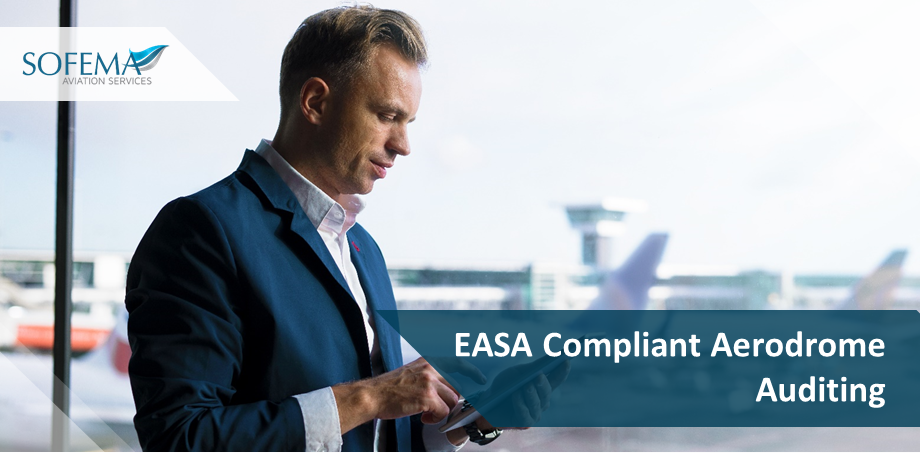Sofema Aviation Services (SAS) www.sassofia.com considers typical Aerodrome Auditing elements across multiple business areas and elements. The following issues and challenges are considered for each element.
- Related to the effectiveness of ensuring EASA compliance as per EASA and ICAO requirements, certified aerodromes shall demonstrate and continually monitor compliance with the requirements through aerodrome audits and inspections.
Introduction Legal Obligations
The EASA / ICAO requirements and other best practices can briefly be summarized as follows:
- Aerodrome operators shall establish a compliance monitoring function which coordinates and conducts audits to ensure safe and compliant activities.
- Accountable managers should ensure that sufficient resources are allocated for compliance monitoring.
- After issuance of a certificate, an audit schedule shall be defined. Aerodromes shall audit their key processes, procedures and operations within 12 months. Afterwards, a full audit cycle shall not exceed 36 months.
- Personnel involved in compliance monitoring, including inspectors and auditors, shall be trained accordingly, and know the subject being audited.
- Audits and inspections shall not be carried out by personnel responsible for the function, procedure, etc. being audited.
Ensuring Best Practices related to EASA compliant Auditing and Oversight of European airports. please discuss auditing of the following related to ensure an effective and compliant aerodrome operation
Aerodrome Management of Change
Management of Change refers to the systematic approach to dealing with alterations or changes in an organization, its operations, or its safety systems.
The Management of Change is a dynamic process that requires a structured approach to ensure that changes are implemented safely and efficiently.
Regular audits, both internal and external, are essential to ensure compliance with EASA standards and to maintain the highest levels of safety and efficiency in aerodrome operations.
- In the context of aerodrome operations, this can encompass changes in infrastructure, equipment, personnel, procedures, or even the introduction of new technologies.
- Ensure that the airport has a clear and documented policy on how changes are managed.
- All changes, including the reasons for the change, risk assessments, consultations, and approvals, should be documented.
- Ensure that all changes comply with EASA regulations and any other relevant national or international standards.
- Any proposed change should undergo a risk assessment to identify potential hazards and assess the risks associated with the change.
- All changes, including the reasons for the change, risk assessments, consultations, and approvals, should be documented.
- Relevant stakeholders, including airlines, ground handlers, air traffic control, and others, should be consulted before implementing significant changes.
- If the change involves new equipment or procedures, ensure that relevant personnel are adequately trained. (Training records should be maintained and reviewed to confirm that staff are competent to handle the new changes.)
- Changes should be implemented systematically and in line with the outlined procedures.
- Post-implementation, there should be a mechanism to monitor the effects of the change to ensure that it has the desired outcomes and that no unforeseen issues arise.
- Periodically, the entire Management of Change process should be reviewed to identify areas of improvement.
Compliance Monitoring:
Compliance monitoring, particularly through systematic auditing, is essential for ensuring that European airports operate safely, efficiently, and in line with EASA and other relevant regulations. Regular audits, both internal and external, combined with a robust CMS, ensure that non-compliances are identified and addressed promptly.
Auditors should be adequately trained to understand the regulations, standards, and best practices related to aerodrome operations. (Continuous professional development ensures that auditors remain up to date with changes in the industry and regulatory environment.)
- Compliance Monitoring is a systematic process to ensure that the organization’s operations and procedures comply with the relevant regulatory requirements.
- For aerodromes, this means ensuring that all operations, infrastructure, and services meet the standards set by EASA and other relevant bodies.
EASA requires aerodromes to establish a CMS. This system should:
- Identify applicable regulations and standards.
- Monitor compliance with these regulations and standards.
- Identify and record instances of non-compliance.
- Implement corrective actions to address non-compliance.
- Continuously improve the CMS.
Internal Audits are typically conducted by the aerodrome’s own personnel or designated representatives. The purpose is to assess the effectiveness of the CMS and to identify areas of non-compliance or potential improvement.
- For any identified non-compliances, corrective actions should be proposed, implemented, and monitored to ensure they effectively address the issue.
- The effectiveness of corrective actions should be reviewed in subsequent audits.
- Feedback from audits should be used to improve the CMS and the overall safety and efficiency of aerodrome operations.
- Regular reviews of the CMS ensure that it remains effective and relevant, especially as regulations, operations, or the aerodrome’s environment change.
Next Steps
Follow this link to our Library to find & download related documents for Free.
Please see EASA Airports Aviation Compliance Management and Auditing – 4 Days For additional guidance please email team@sassofia.com
Tags:
Aerodrome Auditing, Aerodrome Operators, Business Areas Overview, Compliance Monitoring, EASA, EASA Aviation Compliance Management and Auditing, European airports, ground handlers, ICAO requirements, Internal Audits, Management of Change, Regulatory Requirements, SAS blogs, SAS Library




